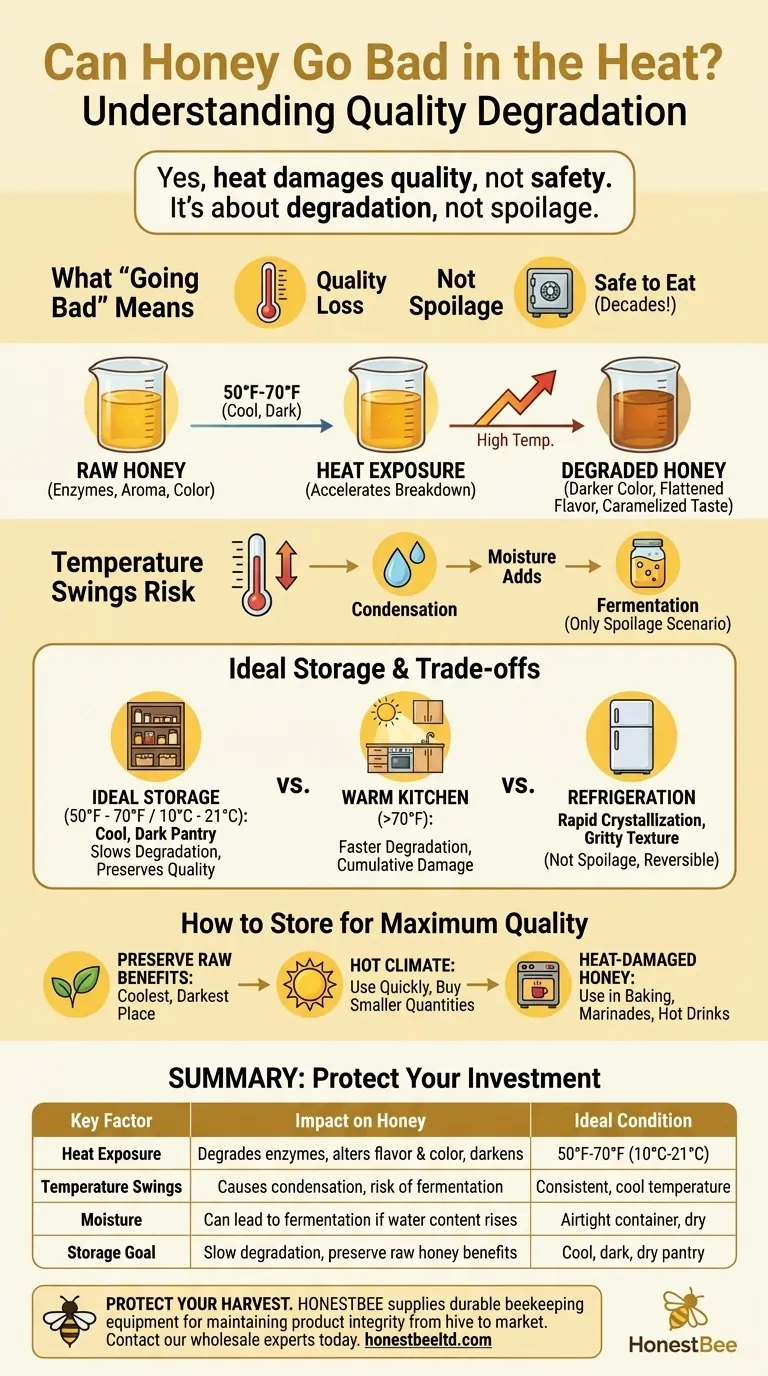Yes, heat can damage the quality of honey, but it's crucial to understand what "going bad" means. Honey doesn't spoil in the traditional sense, like milk or meat. Instead, excessive heat accelerates the breakdown of its delicate enzymes and sugars, permanently altering its flavor, aroma, and color.
Honey is remarkably stable, but its quality is not invincible. The core issue isn't safety, but degradation; heat is the primary factor that will strip honey of its unique character and beneficial properties over time.

What "Going Bad" Actually Means for Honey
Honey's natural composition—low water content and high acidity—makes it an incredibly inhospitable environment for bacteria and mold. It can last for decades, even centuries. When we talk about honey "going bad," we are referring to the loss of its quality.
It's About Degradation, Not Spoilage
The primary concern with heat is the degradation of quality. Honey that has been exposed to high temperatures is still safe to eat, but it will not be the same product you started with.
The Role of Heat and Enzymes
Raw and minimally processed honey contains natural enzymes and volatile compounds that create its unique flavor and aroma profile. Excessive heat—even just room temperature in a hot climate—speeds up enzymatic activity, breaking down these delicate components.
Darkening Color and Altered Flavor
One of the most obvious signs of heat damage is a change in color. The honey will darken significantly. Its flavor profile will also flatten, losing its nuanced floral or fruity notes and potentially taking on a more one-dimensional, almost caramelized taste.
The Problem with Temperature Swings
Consistent temperature is just as important as the temperature itself. Storing honey where the temperature fluctuates can introduce a different kind of problem.
The Condensation Risk
When a container of honey goes from cool to warm, condensation can form on the inside surface. This introduces a small amount of water to the honey.
Why Moisture Can Lead to Fermentation
While honey's low water content prevents spoilage, adding moisture to the top layer can raise the water content just enough to allow naturally occurring osmophilic yeasts to begin fermentation. This is the one scenario where honey can truly spoil.
Understanding the Trade-offs
The goal of proper storage is to slow down the inevitable process of degradation as much as possible.
The Ideal Storage Temperature
The optimal temperature for preserving honey's quality is a consistent 50°F to 70°F (10°C to 21°C). A cool, dark pantry away from appliances like stoves or dishwashers is the ideal environment.
The Reality of a Warm Kitchen
Storing honey in a kitchen that regularly gets warmer than 70°F won't ruin it overnight. However, the degradation process will be faster. The damage is cumulative; the longer it's stored in a warm spot, the more its quality will diminish.
Why You Should Avoid Refrigeration
While it may seem like a solution for a hot climate, refrigerating honey is not recommended. The cold temperature rapidly accelerates crystallization, turning the honey into a thick, gritty, and nearly solid state. This is not spoilage and can be reversed, but it is an inconvenience.
How to Store Your Honey for Maximum Quality
Your storage strategy should align with your goal for the honey you have.
- If your primary focus is preserving the full benefits and flavor of raw honey: Store it in the coolest, darkest, and most temperature-stable place in your home, like a pantry or cupboard.
- If you live in a very hot climate without air conditioning: Use your honey more quickly. Avoid buying large quantities that will sit for months in a warm environment.
- If you suspect your honey has been heat-damaged: It is perfectly safe to use. Simply relegate it for use in baking, marinades, or as a sweetener in hot drinks where its nuanced flavors are less critical.
Ultimately, protecting your honey from heat is about preserving the delicate quality that makes it a unique and valuable food.
Summary Table:
| Key Factor | Impact on Honey | Ideal Condition |
|---|---|---|
| Heat Exposure | Degrades enzymes, alters flavor & color, darkens honey | Store at 50°F-70°F (10°C-21°C) |
| Temperature Swings | Causes condensation, risk of fermentation | Consistent, cool temperature |
| Moisture | Can lead to fermentation if water content rises | Store in airtight container |
| Storage Goal | Slow degradation, preserve raw honey benefits | Cool, dark, dry pantry |
Protect the quality of your honey harvest and your investment.
For commercial apiaries and beekeeping equipment distributors, proper storage and handling are critical for maintaining product integrity. HONESTBEE supplies durable, high-quality beekeeping supplies and equipment—from honey storage containers to temperature-controlled solutions—designed to help you preserve your honey's value from hive to market.
Contact our wholesale experts today to discuss your supply needs and ensure your honey retains its premium quality.
Visual Guide

Related Products
- Inverted Squeezable Honey Jar with No Drip Flip Top Cap for Easy Pouring
- Classic Honey Bear Jars with Flip Top Dispensing Cap for Liquid Sweeteners
- Natural Wood Honey Dipper for Tea Coffee and Desserts
- Modern Honeycomb Pattern Wooden Honey Dipper for Stirring and Drizzling
- Premium Heat-Resistant Glass Honey Dipper
People Also Ask
- What are the benefits of using glass jars for honey packaging? Preserve Flavor & Elevate Your Brand
- What is done with the honey after extraction and filtering? From Purification to Perfect Packaging
- How long do you let honey sit before bottling? Achieve Crystal-Clear Honey for Your Business
- What causes honey to crystallize? A Guide to Natural, High-Quality Honey
- What factors should be considered when choosing honey packaging? Optimize for Brand, Operations & Market



















